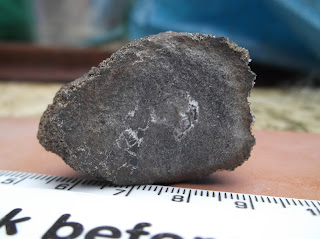The first image shows the approach down the deep beck valley side of maltby beck to the excavation.
The second image shows the early stages of the excavation, even at this stage i was in no doubt that i had found yet another continuation of the Stainton gravel beds.
The third image shows the gravel bed becoming more apparent, as are the deposits both above and below identical in make up and thickness as at my main stainton excavation at Stainton beck just short of a mile east

The fourth image shows my first bone find embedded deep in the gravel bed.

Image 6 shows the bone released and covered in a concretion.

The seventh image shows a horse upper molar, these gravel beds ime told must be over 20.000 years old, yet ive also been told by professionals in the past that there were no horses in this area around that time !!! well ive found plenty.

image 8 shows the end of the excavation for the day, the Stainton gravel bed can clearly be seen.

Image 9 shows either a Bos or Bison tooth.
The remaining images show the washed and dried bone found, the larger bone is a piece of a tibia but its to damaged to id.

Heath,
Teeth and bones start out as the mineral Hydroxylapatite (with some organic components too). During long burial in soil, some of the hydroxyl part (the "(OH)" in the chemical formula) can slowly get replaced by fluorine (F), and eventually the mineral part turns into the mineral Fluorapatite, which is a bit more resistant than the original Hydroxylapatite. There have been attempts to date old teeth and bones by the amount of fluorine they've absorbed, but I imagine there are so many variables involved that the results would be only a little bit superior to guesswork, although I haven't studied the method..
That's the reason that toothpaste contains "fluoride" - It's an attempt to speed up the replacement of the Hydroxylapatite in our teeth by Fluorapatite, making them more resistant to decay.
Depending on the soil chemistry in your area, other minerals could be entering the teeth too, like iron oxides, iron phosphates (vivianite, etc.), aluminium phosphates (variscite, etc.). The dark colour isn't necessarily from a mineral, however; it could be from the decomposition of the organic part of the tooth.
Cheers
Thanks for that Petrov
Update on this excavation 26,8,2012
I excavated another metre in today although i did not discover as many fossils as usual, i did uncover this lower jaw piece, i also discovered a rich organic section below the tightly packed gravel bed.
The first image shows the sit before i started the second excavation.
Image two shows the upper jaw piece, i t was excavated about 2 metres into the packed gravel bed.
Image three shows the separate sequence of layers as at the main excavation at Stainton beck about a mile to the east.
Image four and five show the mandible after being washed.
Update on excavated fossils
This piece has coating a of many different small crystals the main stone is full of small Ammonites and coral among other unidentified pieces
This piece was also excavated
The geological layers at this location are as follows-
Red - brown loamy friable almost stoneless clay.
Blue grey sandy clay containing organic material average thickness 100mm
Stainton gravel bed containing fossils and preserved mammall bones.
Mixture of sandy clay deposits and plastic almost stoneless red clay.
 The end of today's excavation only one bone was found and no fossils, but as at Stainton and all the other excavations the bed was full of unrounded whinstone.
The end of today's excavation only one bone was found and no fossils, but as at Stainton and all the other excavations the bed was full of unrounded whinstone.












































